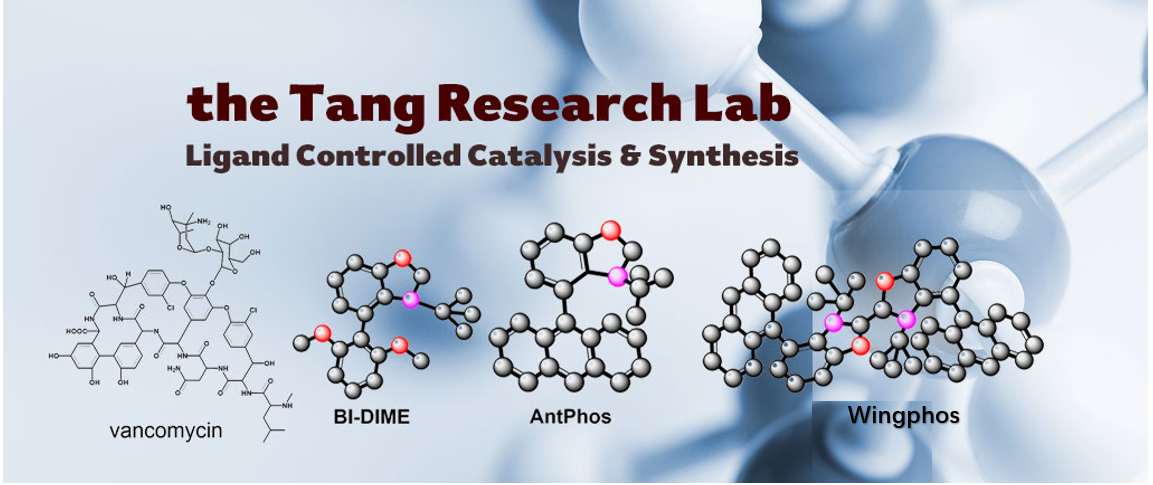 |
Research |
Research Overview in Tang Lab |
|
We are fortunate to live in this era and witness the great changes in this growing world at an ever-fast pace. Chemistry are inseparable to our daily life, serving as the central science to many important areas including energy, material, health, and communications, It is our hope that research in our lab will sooner and later help improve the quality of your life by building molecules more efficiently and providing better solutions to current existing issues related to medicines, materials, and energy.  We are interested in developing efficient catalytic reactions for building carbon-carbon, carbon-hydrogen, and carbon-heteroatom bonds with particular emphasis on selectivity (including chemoselectivity, regioselectivity, and enantioselectivity), cost, and environmental impact. The reactions should on one hand be relevant to the efficient synthesis of biological interesting natural products or drugs. Hence, their applications in total synthesis of complex natural products or drugs will be explored and demonstrated. On the other hand, a few of the reactions in our lab could be highly important for manufacture of medicines, agrochemicals, or new products in energy and material sciences. Their scale-up processes will also be developed and demonstrated for industrial realization.Development of efficient ligands and catalysts for new reactivity and selectivity is our ongoing passion in daily research. |
Research directions:
|
1. Design and development of efficient, practical, and industrially viable catalytic reactions
|
|||||||||||||||||||||||||||||||||||
a. Development of novel, efficient, and structurally unique phosphorus ligands |
||
|
Over years, we have developed a series of efficient and practical P-chiral bis- and mono-phosphorus ligands that have been applied extensively in both academia and industry. Their unique structural and physical properties include P-chirality, conformational unambigueousness, high tunability of electronic and steric properties, and operational simplicity as air-stable solids, making them exceptional ligands for a number of asymmetric catalytic reactions. Over 100 phosphorus ligands developed in our group are currently available in Strem as well as many Chinese vendors. A number of phosphorus ligands such as BI-DIME, AntPhos, MeO-BIBOP, MeO-POP, and BaryPhos developed in our lab are currently being applied in kilogram scales in pharmaceutical industry. More efficient ligands or catalysts for various important reactions are currently under investigation in our laboratory. (Acc. Chem. Res. 2019, 52, 1101-1112; Aldrichimica ACTA 2020, 53, 27; The Strem Chemiker, 2019, XXXI, 1; https://www.x-mol.com/news/568521).  |
|
b. Development of efficient cross-coupling reactions |
||
|
Development of efficient, sterically hindered carbon-carbon and carbon-heteroatom bond-forming reactions with high yields, ees, and TONs is our ongoing research interest. (Synlett 2016, 27, 2183). Through design of phosphorus ligands, we have developed sterically hindered aryl-aryl cross-coupling (Angew. Chem. Int. Ed. 2010, 49, 5879; Chem. Eur. J. 2013, 19, 2261), sterically hindered aryl-alkyl cross-coupling (Angew. Chem. Int. Ed. 2015, 54, 3792; Org. Chem. Front. 2014, 1, 225), asymmetric aryl-aryl cross-coupling (J. Am. Chem. Soc. 2014, 136, 570; J. Am. Chem. Soc. 2020, 142, 8036); Asymmetric dearomative cross-coupling (Angew. Chem. Int. Ed. 2015, 54, 3033; Chem. Sci. 2017, 8, 6247; J. Am. Chem. Soc. 2017, 139, 6630), asymmetric aryl-alkyl cross-coupling (Angew. Chem. Int. Ed. 2019, 58, 11355; Org. Lett. 2020, 13, 4974), asymmetric α-arylation (Angew. Chem. Int. Ed. 2018, 55, 5044; Org. Lett. 2020, 22, 4602), and very recently asymmetric carbonylation (Angew. Chem. Int. Ed. 2021, 60, 9978; Angew. Chem. Int. Ed. 2021, 60, 6305) with particular interests in developing new catalytic mode and concept.  |
|
c. Asymmetric hydrogenation |
||
|
Our P-chiral phosphorus ligands have enabled efficient syntheses of various chiral amines in excellent ees and TONs. Recently, we are keen to develop efficient asymmetric hydrogenation of tetrasubstituted olefins and substituted benzenes (Angew. Chem. Int. Ed. 2019, 58, 13573-13583).  |
|
d. Enantioselective Reductive Coupling of Imines Templated by Chiral Diboron |
||
|
The serendipitous discovery of diboron-participated [3,3]-sigmatropic rearrangement has become a general, practical, and highly efficient method for the synthesis of chiral vicinal chiral diamines. The protocol features high enantioselectivity and stereospecificity, mild reaction conditions, simple operating procedures, use of readily available starting materials, and a broad substrate scope. The method signifies the generality of diboron-participated [3,3]-sigmatropic rearrangement (J. Am. Chem. Soc. 2020, 142, 10337; J. Am. Chem. Soc. 2017, 139, 9767).The industrialization of this method is currently ongoing in ZejunPharma.  |
2. Total synthesis of complex and biologically active natural products
|
Using asymmetric Suzuki-Miyaura cross-couplings, dearomative cyclizations, and sterically hindered α-arylations as key steps, we have accomplished the asymmetric syntheses of a number of terpenes, steroids, alkaloids and polyketides in a concise and highly efficient manner. (Chem. Rec. 2020, 20, 23). A number of chiral natural products were synthesized through enantioselective fashions for the first time (J. Am. Chem. Soc. 2014, 136, 570; J. Am. Chem. Soc. 2020, 142, 8036; Angew. Chem. Int. Ed. 2015, 54, 3033; Chem. Sci. 2017, 8, 6247; J. Am. Chem. Soc. 2017, 139, 6630; Angew. Chem. Int. Ed. 2018, 55, 5044; Chem. Sci. 2021, doi: 10.1039/D1SC02919C).  |
3. Development of efficient, economical, and green chemical processes for pharmaceutically important molecules
|
||
|
This is our ongoing goal. Over years we have developed efficient enantioselective syntheses of escitalopram, silodosin, oxycodone, gossypol, tofacitinib, and recently steroid drugs. |
@ 2015. The Tang Group. All rights reserved.